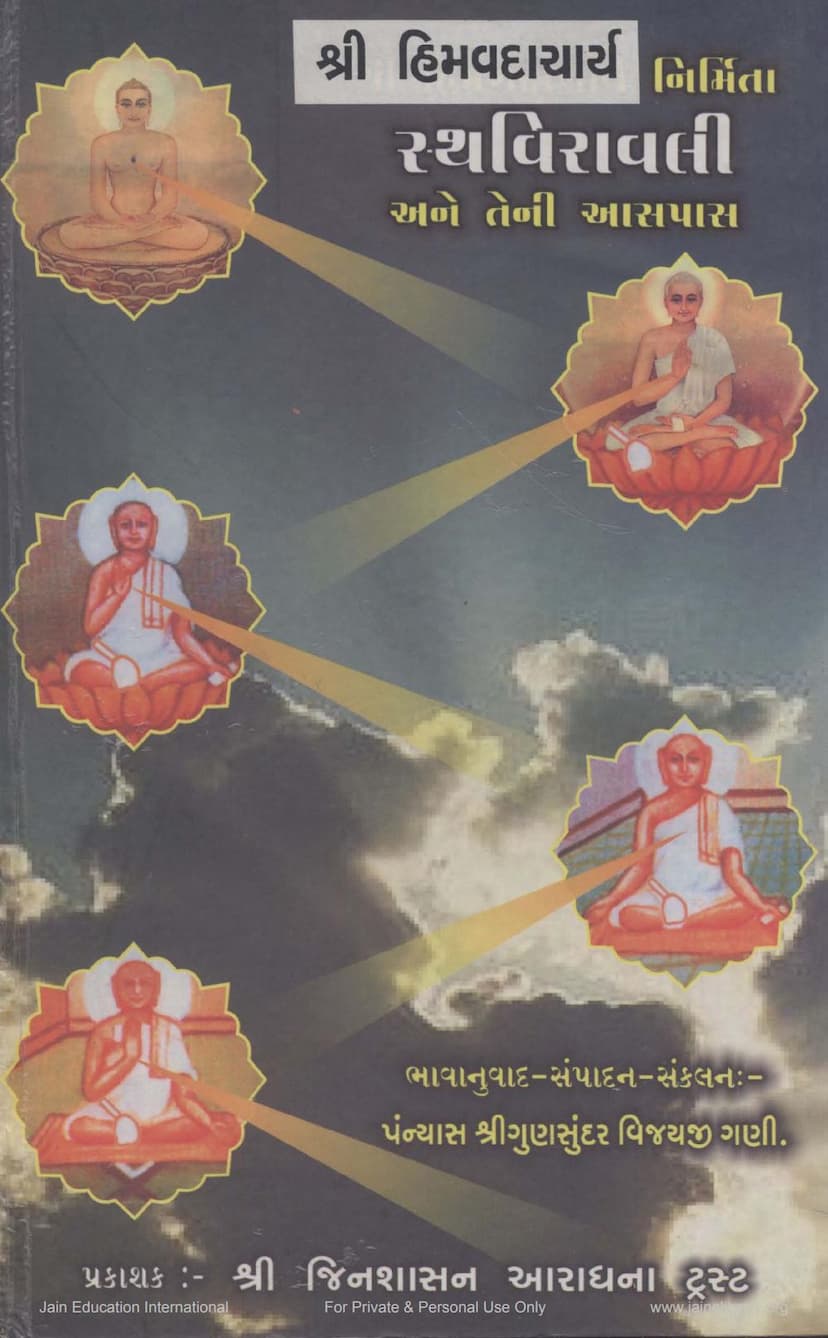Sthaviravali Ane Teni Aaspas
Added to library: September 2, 2025

Summary
"Sthaviravali ane Teni Aaspas" (The Chronicle of Elders and Their Surroundings), authored by Gunsundarvijay and published by Jinshasan Aradhana Trust, is a comprehensive work that delves into the rich history and lineage of prominent Jain monks and the historical context surrounding them. Based on the provided text, here's a summary of its key aspects:
Core Content and Purpose:
The book's primary objective is to document and illuminate the lives and contributions of significant Jain monks, referred to as "Sthaviras" (elders or venerable figures). It aims to trace their historical importance, their spiritual lineage, and the cultural and religious milieu in which they lived and propagated Jainism. The title itself suggests an exploration of not just the individuals but also the "surroundings" – the historical events, geographical locations, and societal influences that shaped their lives and the Jain tradition.
Key Themes and Content Areas:
-
Genealogy of Jain Ascetics (Sthaviravali): The central part of the book is dedicated to presenting a chronicle of the elders. This likely involves detailing their names, their succession in various monastic orders (Gachhas), their periods of influence, their spiritual achievements, and their key disciples. The text highlights the lineage from prominent figures like Shrī Sudharmaswami (the fifth Ganadhara of Lord Mahavir), Arya Jambūswami (the last Kevali of this era), Arya Prabhava Swamiji, Arya Shyambhavunath, Arya Yashobhadra Suriji, Arya Sambhuti Vijayaji, Arya Bhadrabahu Swamiji, Arya Sthulabhadra, and many others, tracing the transmission of Jain knowledge and tradition through centuries.
-
Historical and Geographical Context: The book situates these Sthaviras within their historical periods and geographical locations. It discusses:
- Ancient Jain Kingdoms and Rulers: Mentions of prominent Jain rulers like King Shrenik, Ajatashatru, Chandragupta Maurya, Ashoka (initially), Samprati, Kharavel, and Vikramaditya. The role of these rulers in patronizing and propagating Jainism is likely highlighted.
- Key Jain Tirthas (Holy Sites): The text extensively details numerous ancient Jain pilgrimage sites, including Ashtapada, Takshashila, Shatrunjay Tirth, Girnar Tirth, Prabhastirtha, Hastinapur, Champapuri, Sammetshikharji, Mathura, Kankali Tila, Ahichhatra, Shankheshwar Parshwanath, Charup, Kambo'i, Vidisha, Sanchi, Udayagiri, Dhumnar, Chandravati, Ghasoi, Dhipuri Tirth, Vellala, Dwarka, Paithan, Bhaddreshwar, Rajagriha, Nalanda, Jivit Swami, Pavapuri, and Siddhagiri (Palitana). The historical significance and Jain associations of these sites are explored.
- Historical Events and Councils: It touches upon significant events like the Jain Agam recensions (Mathuri Vachana, Valabhi Vachana), the impact of famines and invasions, and the evolution of Jain traditions.
-
Monastic Orders and Lineages (Gachhas and Shakhhas): The book elaborates on the establishment and development of various Jain monastic lineages and branches (Gachhas and Shakhhas). It mentions the Upakeshgachha founded by Shrī Keshi Gandhar, the Kālikacharya Gachha, the Pandilagachha, the Chandrakula, the Brahmakripika Shakha, and others, detailing their prominent Acharyas and their contributions.
-
Scholarly and Literary Contributions: The text highlights the intellectual achievements of these Sthaviras, mentioning their authorship of important Jain scriptures, commentaries (Vrutti, Chunni, Bhashya, Tikas), and philosophical treatises. The contributions of scholars like Arya Skandila, Arya Nagardhun, Arya Devalikshapaman, Arya Shāma Sharma, Arya Meghgiri, Arya Suhasthiti, Arya Bhadrabahu Swami, Arya Sthulabhadra, Umāsvati Vachak, and Haribhadra Suri are acknowledged.
-
Debates and Doctrines: The book likely addresses historical debates within Jainism, such as those concerning Sthavirakalpa vs. Jinakalpa, the origins of the Digambara tradition, debates on nudity and other practices, and the differing interpretations of scriptures. It also touches upon the antiquity of Murti Puja (idol worship) in Jainism, referencing archaeological findings and scholarly analyses.
-
Illustrations and Supporting Evidence: The presence of plates and illustrations (like those of the Mathura Kankali Tila sculptures, Jain statues, and inscriptions) indicates a visual approach to historical evidence, reinforcing the textual information.
Key Figures and their Impact:
The book emphasizes the pivotal roles of various Acharyas and monks who shaped Jainism over centuries. Their efforts in preserving and propagating the Jain Agamas, their intellectual prowess in philosophical debates, their dedication to rigorous asceticism, and their influence on rulers and society are likely lauded.
Overall Significance:
"Sthaviravali ane Teni Aaspas" appears to be a foundational text for understanding the historical development of Jain monasticism, the evolution of Jain traditions, and the interplay between Jainism and the broader Indian socio-political and religious landscape. It serves as a valuable resource for scholars, practitioners, and anyone interested in the deep historical roots of Jainism. The emphasis on original sources, scholarly research, and archaeological evidence suggests a rigorous approach to historical reconstruction.